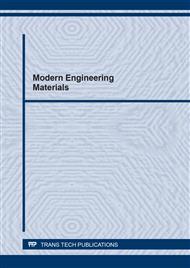[1]
Y. Zhang, H. Wang, W. Gao, F. Wang, N. Zhou, DM Kammen, X. Ying, A Survey of the Status and Challenges of Green Building Development in Various Countries, Sustainability 2019, Vol. 11, Page 5385. 11 (2019) 5385. https://doi.org/10.3390/SU11195385.
DOI: 10.3390/su11195385
Google Scholar
[2]
B.. Venkatarama Reddy, K.. Jagadish, Embodied energy of common and alternative building materials and technologies, Energy and Buildings. 35 (2003). https://doi.org/10.1016/S0378-7788(01)00141-4.
DOI: 10.1016/s0378-7788(01)00141-4
Google Scholar
[3]
A.A. Firoozi, C. Guney Olgun, A.A. Firoozi, M.S. Baghini, Fundamentals of soil stabilization, International Journal of Geo-Engineering 2017 8:1. 8 (2017) 1–16. https://doi.org/10.1186/S40703-017-0064-9.
DOI: 10.1186/s40703-017-0064-9
Google Scholar
[4]
A. Cuccurullo, D. Gallipoli, A.W. Bruno, C. Augarde, P. Hughes, C. La Borderie, Earth stabilization via carbonate precipitation by plant-derived urease for building applications, Geomechanics for Energy and the Environment. (2020). https://doi.org/10.1016/j.gete.2020.100230.
DOI: 10.1016/j.gete.2020.100230
Google Scholar
[5]
E. Nordlander, H. Carlsson, Computational modeling of the mechanism of urease, Bioinorganic Chemistry and Applications. 2010 (2010). https://doi.org/10.1155/2010/364891.
DOI: 10.1155/2010/364891
Google Scholar
[6]
H. Yasuhara, D. Neupane, K. Hayashi, M. Okamura, Experiments and predictions of physical properties of sand cemented by enzymatically-induced carbonate precipitation, Soils and Foundations. 52 (2012). https://doi.org/10.1016/j.sandf.2012.05.011.
DOI: 10.1016/j.sandf.2012.05.011
Google Scholar
[7]
N. Javadi, H. Khodadadi, N. Hamdan, E. Kavazanjian, EICP Treatment of Soil by Using Urease Enzyme Extracted from Watermelon Seeds, (2018) 115–124. https://doi.org/10.1061/9780784481592.012.
DOI: 10.1061/9780784481592.012
Google Scholar
[8]
E. Kavazanjian, N. Hamdan, Enzyme Induced Carbonate Precipitation (EICP) Columns for Ground Improvement, (2015) 2252–2261. https://doi.org/10.1061/9780784479087.209.
DOI: 10.1061/9780784479087.209
Google Scholar
[9]
H.E. Annett, The Urease Content of certain Indian Seeds, Biochemical Journal. 8 (1914) 449–452. https://doi.org/10.1042/bj0080449.
DOI: 10.1042/bj0080449
Google Scholar
[10]
C. Hirayama, M. Sugimura, H. Saito, M. Nakamura, Purification and properties of urease from the leaf of mulberry, Morus alba, Phytochemistry. 53 (2000) 325–330. https://doi.org/10.1016/S0031-9422(99)00521-X.
DOI: 10.1016/s0031-9422(99)00521-x
Google Scholar
[11]
B. Krajewska, S. Ciurli, Jack bean (Canavalia ensiformis) urease. Probing acid-base groups of the active site by pH variation, Plant Physiology and Biochemistry. 43 (2005) 651–658. https://doi.org/10.1016/j.plaphy.2005.05.009.
DOI: 10.1016/j.plaphy.2005.05.009
Google Scholar
[12]
S.-S. Park, S.-G. Choi, I.-H. Nam, Effect of Plant-Induced Calcite Precipitation on the Strength of Sand, Journal of Materials in Civil Engineering. 26 (2014) 06014017. https://doi.org/10.1061/(ASCE)MT.1943-5533.0001029.
DOI: 10.1061/(asce)mt.1943-5533.0001029
Google Scholar
[13]
Y. Gao, J. He, X. Tang, J. Chu, Calcium carbonate precipitation catalyzed by soybean urease as an improvement method for fine-grained soil, Soils and Foundations. 59 (2019) 1631–1637. https://doi.org/10.1016/j.sandf.2019.03.014.
DOI: 10.1016/j.sandf.2019.03.014
Google Scholar
[14]
J. Shaela Pervin, M.; Sarowar, Effects of Some Environmental Variables on Urease in Germinating Chickpea (Cicer arietinum L.) Seed, Journal of Stress Physiology & Biochemistry. 9 (2013) 345–356. https://agris.fao.org/agris-search/search.do?recordID=RU2015100825.
Google Scholar
[15]
B. Knorr, Enzyme-induced carbonate precipitation for the mitigation of fugitive dust, Arizona State University, (2014).
Google Scholar
[16]
S.P. Chaparro-Acuña, M.L. Becerra-Jiménez, J.J. Martínez-Zambrano, H.A. Rojas-Sarmiento, Soil bacteria that precipitate calcium carbonate: Mechanism and applications of the process, Acta Agronomica. 67 (2020) 277–288. https://doi.org/10.15446/ACAG.V67N2.66109.
DOI: 10.15446/acag.v67n2.66109
Google Scholar
[17]
MU. Qureshi, N. Bessaih, K. Al-Sadrani, S. Al-Falahi, A.-M. A., Shear strength of Omani sand treated with biopolymer, In: Bouazza, Abdulmalek (Editor); Yuen, Samuel T S (Editor); Brown, Bruce (Editor). 7th International Congress on Environmental Geotechnics : Iceg2014. [Barton, ACT]: Engineers Australia. (2014) 1158–1165. https://search.informit.org/doi/abs/10.3316/informit.000991677892416.
Google Scholar
[18]
MU. Qureshi, S. Al-Qayoudhi, S. Al-Kindi, A. Al-Hamdani, K. Al-Sadrani, The Effects of Slaking on the Durability of Bio- improved Sand, International Journal of Scientific & Engineering Research. 6 (2015). http://www.ijser.org.
Google Scholar
[19]
MU. Qureshi, I. Chang, K. Al-Sadarani, Strength and durability characteristics of biopolymer-treated desert sand, Geomechanics and Engineering. 12 (2017). https://doi.org/10.12989/gae.2017.12.5.785.
DOI: 10.12989/gae.2017.12.5.785
Google Scholar
[20]
MU. Qureshi, A. Al-Hilly, O. Al-Zeidi, A. Al-Barrami, A. Al-Jabri, Vane shear strength of bio-improved sand reinforced with natural fibre, in: E3S Web of Conferences, 2019. https://doi.org/10.1051/e3sconf/20199212004.
DOI: 10.1051/e3sconf/20199212004
Google Scholar
[21]
G. Kim, J. Kim, H. Youn, Effect of Temperature, pH, and Reaction Duration on Microbially Induced Calcite Precipitation, Applied Sciences 2018, Vol. 8, Page 1277. 8 (2018) 1277. https://doi.org/10.3390/APP8081277.
DOI: 10.3390/app8081277
Google Scholar
[22]
Q. Zhao, L. Li, C. Li, M. Li, F. Amini, H. Zhang, Factors Affecting Improvement of Engineering Properties of MICP-Treated Soil Catalyzed by Bacteria and Urease, Journal of Materials in Civil Engineering. 26 (2014) 04014094. https://doi.org/10.1061/(ASCE)MT.1943-5533.0001013.
DOI: 10.1061/(asce)mt.1943-5533.0001013
Google Scholar


